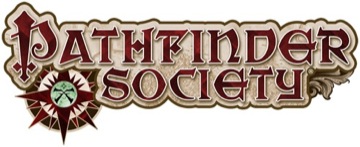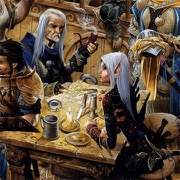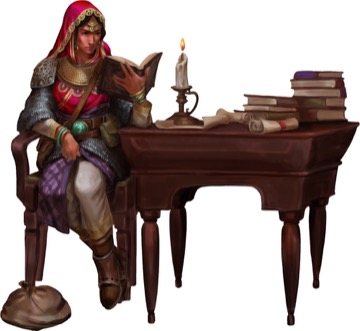Pathfinder Society 2, Expanding on the FAQ
Wednesday, March 14, 2018
By now many of you have heard that Paizo's launching a playtest for a second edition of Pathfinder RPG. This sort of news inspires all sorts of questions, so be sure you've checked out the Pathfinder Playtest FAQ. In short, Paizo will release the playtest book, pdf, and a playtest adventure at Gen Con 2018, gathering your input to revise the game and release it in full at Gen Con 2019.
A new edition inspires changes in other programs, including Pathfinder Society Roleplaying Guild. When the new edition releases in August 2019, we will be launching a Pathfinder Society campaign using the new rules. Scenarios from that month onward will use the new edition, but that doesn't stop you from continuing to play first edition adventures (hundreds scenarios and dozens of sanctioned modules and Adventure Paths) with your first edition PCs.
We answer a lot of preliminary questions in the Pathfinder Society section of the FAQ, but there's a lot more to creating a new campaign than nine questions can detail. Over the next few weeks we'll be sharing more information and soliciting feedback on much more. After all, we've had a long time to consider strategies, but we've had only a little more than a week to discuss the matter with the community without spoiling the announcement. And discussion's an important part of the equation for organized play community; we thrive on incorporating player, GM, and organizer feedback into our decisions to ensure the most fair and fun experience.
So lets look at some preliminary answers together.
Lessons from Starfinder Society
By the time we began creating the Starfinder Society campaign—with much of the heavy lifting done by Thurston Hillman—everyone on the team had years of playing in, designing for, and managing the Pathfinder Society campaign. This was also our first time building an organized play campaign largely from the ground up, and it was gratifying to identify what had worked and what hadn't aged well in order to create a great program. In saying this, I do want to dispel one myth: Starfinder Society wasn't a prototype for a second edition Pathfinder Society campaign. It represented our creating a great organized play campaign informed by hard-learned lessons and years of inspiration. As we look toward creating a new Pathfinder Society campaign, we're learning from both the first edition experiences and Starfinder Society's success to create another great organized play program.
So what's worked well for Starfinder Society? Short answer's "A whole lot of things," and the team's impression is that many of these could work very well in Pathfinder Society, too. Let's break that down into subtopics.
Smaller Tiers: Pathfinder Society's first edition uses a 5-level spread for its tiers (e.g. Tier 1-5), breaking that into two subtiers (e.g. Subtiers 1-2 and 4-5). Although this has worked well from the perspective of allowing as many characters as possible to play each adventure, it leaves an awkward out-of-subtier gap. Also, the wider the level range, the easier it is for someone on the low end of that range to end up facing a wildly overpowering foe in the higher subtier; the same's true for very high level PCs practically walking over low-subtier threats. On the other hand, Starfinder Society uses a 4-level spread for its tiers (e.g. Tier 1-4) with two subtiers (e.g. Subtiers 1-2 and 3-4), eliminating the out-of-subtier gap and tightening the difficulty ranges for the encounters.
Overall, we're inclined to switch to this 4-level tier model, which would include Tiers 1-4, 3-6, 5-8, 7-10, and so on. We've opened up a Tiers and Level Gain thread to solicit your insights, so be sure to join the conversation there.
Boons: Starfinder Society boons—everything from the story awards earned during scenarios to the incentives distributed at public events—underwent a major revision in the form of boon slots. With some exceptions, each boon belongs to one of six categories: Ally, Faction, Personal, Promotional, Social, or Starship. At the beginning of each scenario, after hearing the mission's briefing, each player takes a moment to assign up to one boon of each type into its respective boon slot. There were several goals here. First, it gave us a clean way to handle our new faction model (see below). Second, it meant that players didn't have to shuffle through piles of Chronicle sheets mid-game to find a boon but could instead ready boons at the beginning of the adventure. Third, it helped us balance boon design around the idea that each PC would have a limited number of boons rather than dozens upon dozens of minor bonuses for which the Pathfinder rules simply don't account. By being really clear in scenarios when a boon might be useful to a player, I feel we've also promoted transparency, not yanked out the rug from under players.
All told, we've been really happy with how Starfinder Society boons work, and our inclination is to translate that system over to our second edition campaign. Naturally, we'd replace the Starship slot with something more genre appropriate (I know, I know... I just ruined one of your character concepts, didn't I?).
But that's our take, and we want to know how you feel about how boons would factor into the new campaign. Let us know in the Boons thread.
Factions and Fame: Okay, let's get one complaint out on the table: the Prestige Points/Fame/Reputation definitions aren't completely consistent between Pathfinder Society and Starfinder Society. We recognized that going in, but we also balanced that against a desire to set Fame and Infamy in opposition to each other and just have shorter, cleaner terms overall. The odds are good that we'll adopt similar terminology in the new campaign.
Starfinder made some significant changes to how factions and Fame work. The most dramatic change is that each PC can work with any number of factions, slotting in a different faction champion boon at the beginning of any adventure to represent that allegiance. The especially devoted can stick to one faction, of course, but the options are there. What's more, factions in Starfinders provide about a dozen purchasable boons each, many of which might remind you of the vanities from Pathfinder Society. The more you serve a faction, the higher your status with them, and the more impressive the boons you can buy with your Fame. The drawback's that these took us a lot of time to create (especially Thursty, who handled the majority of the wordsmithing), but they've given each faction a much deeper role, both narratively and mechanically.
We're strongly looking to adopt the same faction model for second edition, giving PCs the freedom to work with an assortment of factions and purchase faction-themed benefits. We want to hear what you think in the Factions and Fame thread.
During the first few seasons, the Society's factions fought with one another in the Shadow War for control over Absalom. The intrigue was compelling, but the tight-lipped secrecy and occasional elements of backstabbing weren't especially conducive to playing a cooperative game. In the past five years I feel the factions have reached a comfortable equilibrium of working with the Society while also pursuing their own objectives (and sometimes pulling the Society along for the ride). Starfinder Society's also done a great job with this, showing how each faction is a facet of what drives the diverse cast of Starfinders. What's your take? Let us know in that discussion thread.
Finally, any discussion of the factions begs the question "Which factions will appear in second edition?" Well, we already know about some more faction developments coming down the pipeline later in Season 9 and Season 10. Beyond that, though, I'll be frank: we haven't locked in anything. Some factions might step back or merge. Some new ones might appear. All I can say is that the fewer the factions, the more we attention we can give them.
Chronicle Sheets
Around four years ago, the team created numerous prototypes for a new Chronicle sheet, shifting all of the information boxes to the top (rather than splitting it along the top, bottom, and side), juggling various features, and even eliminating certain entries altogether. We eventually returned to the original concept but tinkered with the layout and information fields in smaller ways. I admit that at this point I'm comfortably fond of the current design. I'm also not a graphic designer, and I'm sure that there are countless ways we could improve the Chronicle sheet to make it easier for players to find information and easier for GMs to fill them out—all while maintaining a visually attractive format.
At this point there's no final design. Instead, we're soliciting your feedback in the Chronicle sheets thread. What would help you keep track of your rewards, minimize paperwork, and not impose an undue burden on the GMs?
Oh! I almost forgot: there are already plans in the works for how to ensure that items on the Chronicle sheets are relevant without undermining a PC's general access to other gear through Fame (or a similar mechanic). Until there's more news from the design team about equipment, though, I'm going to leave it at that.
Organizing the Guide
A new campaign demands a new Pathfinder Society Roleplaying Guild Guide. The Guide's gone through around 10 revisions in its lifetime, and it's certainly become a complex creation over the years. That said, Tonya's efforts to reorganize the document with major help from our guide review team (a group of venture-officers who help us identify inconsistencies and places for improvement) have helped break the veritable tome into more easily printed, essential sections.
We feel the Guide's in a pretty good place now, and we'll certainly apply many of the lessons learned when creating the next Guide. That said, we want to hear from the people who are using this document on a regular basis. Tell us what you'd want to see in a redesigned Guide—layout, organization, information, and more—in our Structure of the Roleplaying Guild Guide thread.
Character Numbers
Player numbers are going to stay the same in the new edition's campaign. Much as Starfinder Society character numbers began at -701, you'll find that any playtest characters are going to start at -1501, and second edition characters will start at -2001. I imagine this won't be contentious, but speak up if you foresee some hidden issue with this numbering scheme.
That does raise the question of how we're tracking playtest credit, doesn't it? Does that credit translate into second edition Chronicle sheets? Not quite, but potentially. That's something for a later blog.
GM Stars
When Starfinder Society started up, we recognized that five GM stars wouldn't necessarily correspond to proficiency with the Starfinder rules. Certainly GM stars conveyed dedication to organized play as a whole and comfort "behind the screen," yet we needed a separate means of tracking one's Starfinder Society accomplishments. As we look toward the second edition of Pathfinder RPG, we're seeing similar indicators.
That means a few things. First, it means that we're looking to introduce an additional means of tracking GMs' efforts in second edition games. Second, it means that first edition GM stars aren't disappearing; their principle impact is on the first edition campaign, and they remain the celebrated badge of honor for a GM's contributions. Third, we recognize that this may disappoint some folks, and we're looking at ways to balance this by making players' experiences and GMs' efforts relevant in the new campaign. We're reviewing the ongoing commentary and soliciting opinions in an ongoing process of establishing this policy's details—matters we'll discuss in a future blog.
Character Conversions
As we stated in the Pathfinder Playtest FAQ, we are not converting first edition characters into second edition characters. This may be the toughest decision we've had to make. Like me, you probably have several folders of characters with lots of Chronicle sheets and tales yet to be told. Not only are we providing lots of options to tell meaningful stories with those characters in the coming months, but we're also including various ways to carry your gaming experience over from one campaign to the next. This is an ongoing process and one that we'll address in a future blog.
Season 10
Okay, that's a lot to digest for the second edition. Let's talk a little about Season 10. I've seen a lot of threads and posts noting that Season 10 needs higher-level scenarios, should wrap up some ongoing stories, and should go out with a bang.
The organized play team agrees entirely!
We traditionally announce our new season's name at PaizoCon and hint at some of the awesome stories to come, and I'm not going to spoil that today. I will, however, say that we have some Big Plans for the first edition campaign's final scenarios. We're also thoroughly aware that many of you want to pit your favorite characters against higher-level challenges, so we're reducing the number of lower level scenarios published noticeably for Season 10 while increasing the number of Tier 5-9, 7-11, 12-15 adventures (perhaps higher). There's so much great story content in the works, and we look forward to sharing it over the coming months.
Our New Developer
We have a lot on the horizon and a lot of work ahead, and we're excited to have Michael Sayre join the organized play team as a developer. He's been working on the upcoming Pathfinder Society Scenario #9-16: Fallen Family, Broken Name, and we're looking forward to the great things he'll bring the Pathfinder Society campaign. With Michael on board, I'll be spending more of my time helping Thursty on Starfinder Society development and working on the upcoming playtest scenarios, and our larger team means more opportunity for all of us to help spin up the next edition's Pathfinder Society Roleplaying Guild.
John Compton
Organized Play Lead Developer
We have updated our Privacy Policy.
Paizo.com uses cookies. You can block paizo.com from using cookies within your browser settings, but doing so will hinder site functionality.
More information can be found in our Privacy Policy.



